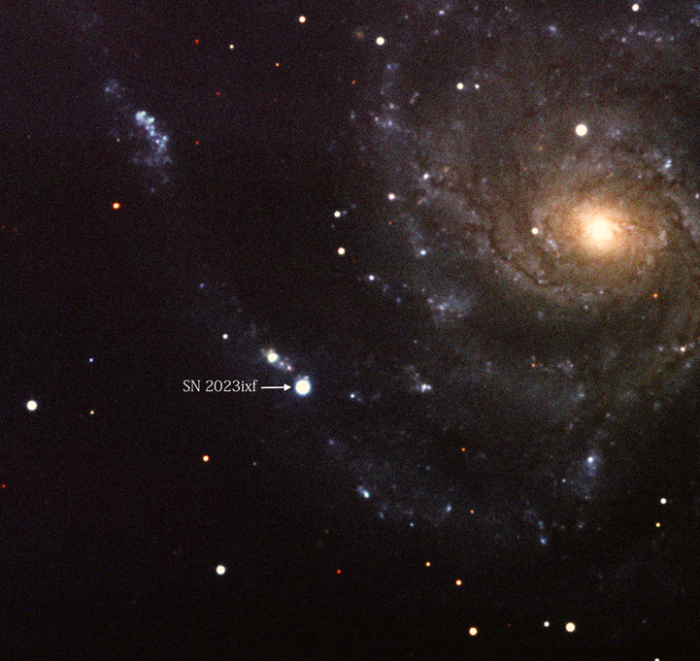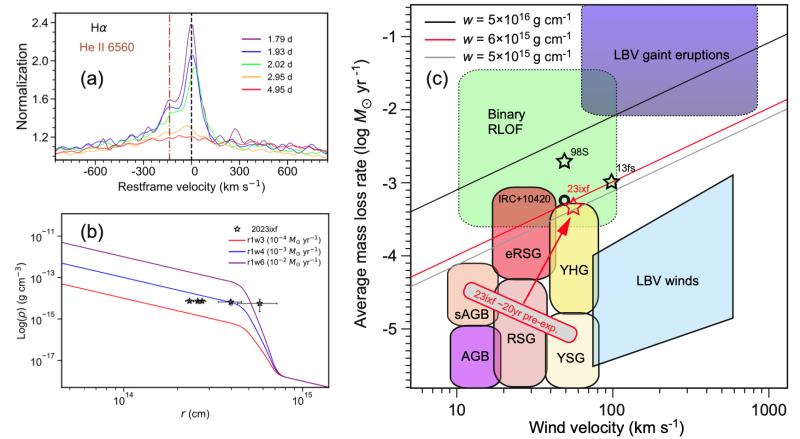Recently, an investigation about the flash spectra of supernova led by Dr. ZHANG Jujia from Yunnan Observatories and Prof. WANG Xiaofeng from Tsinghua University was published online in the journal Science Bulletin. This work revealed the stellar mass violently ejected from the progenitor at the end of its life by observing the once-in-a-decade supernova SN 2023ixf. Such mass loss processes can provide essential information for understanding the final evolution of a massive star.
Type II supernovae (SNe II) are the most common stellar explosions in the Universe, for which the final stage of evolution of their hydrogen-rich massive progenitors towards core-collapse explosion is elusive. The final stage evolution and the resultant circumstellar environments have led to a rich diversity of such explosions. To establish a link between the explosion of SNe II and the late-time evolution of massive stars, it is necessary to capture the first-light signals of the SN explosions, i.e.the flashed spectra, due to the ionization of the circumstellar material (CSM)/stellar wind by ultraviolet/high energy photons from shock breakout cooling.
The recent explosion of SN 2023ixf in a very nearby galaxy, Messier 101, provides a rare opportunity to address this long-standing issue. Timely, high-cadence flash spectra taken within 1-5 days of the explosion allow researchers to place stringent constraints on the properties of the surrounding circumstellar material surrounding this supernova.
It is estimated that the progenitor of SN 2023ixf lost material at a mass-loss rate of 6 × 10-4 M⊙ yr-1 during the last 2-3 years before the explosion. This nearby material, moving at a velocity of 55 km s-1, accumulates a compact CSM shell within a radius of less than 7 × 1014cm from the progenitor. Given the high mass-loss rate and relatively high wind velocity presented here, together with the pre-explosion observations made about two decades ago, the progenitor of SN 2023ixf could be a short-lived yellow hypergiant that evolved from a red supergiant shortly before the explosion.
Thanks to the fast-response system of the Lijiang 2.4 m telescope and the Xinglong 2.16 m telescope, this work took advantage of both temporal sampling and spectral resolution. This helps to place strict constraints on the estimation of wind velocity and mass-loss rate. Then, to reveal the CSM structure, derive the progenitor evolution and infer the increase in mass loss rate. All of these can provide a new view of supernovae to understand the development of massive stars.
The observation and investigation of SN 2023ixf is ongoing. A series of works on this SN will make it a milestone in the history of SNe II and will then help to reveal the fate of massive stars in the mass range from 10 to 20 M⊙.

Fig 1. SN 2023ixf and its host galaxy.

Fig 2. CSM configuration and mass loss history of SN 203ixf. (a): The rapid evolved Hα emission in the early flash spectra. (b): The configuration of CSM. (c): The sharply increased mass loss rate prior to the explosion of SN 2023ixf.
Contact:
ZHANG Jujia
Yunnan Observatories, CAS
E-mail: jujia@ynao.ac.cn